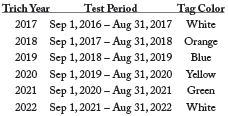 Trichomoniasis is a venereal disease among cattle that can cause abortions, low pregnancy rates and delayed or prolonged calving seasons. The disease is present in the U.S., and can have severe economic costs for Washington’s beef producers.
Trichomoniasis is a venereal disease among cattle that can cause abortions, low pregnancy rates and delayed or prolonged calving seasons. The disease is present in the U.S., and can have severe economic costs for Washington’s beef producers.
Tight economic conditions may allow the disease to spread undetected (e.g. less pregnancy checking, longer breeding seasons, purchase of bargain cows), but trichomoniasis can be prevented and controlled through management.
Cause
Trichomoniasis is caused by a sexually transmitted parasite (Tritrichomonas foetus). The protozoa can survive and grow in the folds of the sheath and crypts in the penile mucosa. Bulls over three years of age rarely clear the parasite once they become infected, and serve as long-term carriers.
The parasite may also live in the reproductive tract of infected cows, though they often clear the infection within three months. Immunity to trichomoniasis lasts less than a year, so cows may be re-infected. Some infected cows may carry the infection into the next breeding season.
Spread
Trichomoniasis is spread by breeding activity. Infected bulls continue to breed normally and spread the infection to cows, which pass it to uninfected bulls when they rebreed. Bull-to-bull transmission is rare; cow-to-cow transmission does not occur.
Trichomoniasis is more common in breeding pastures where multiple herds are purposely or inadvertently mixed (e.g. community pastures) or in operations that purchase open cows or mature, untested breeding bulls. The parasite is sensitive to freezing, drying, and sunlight, and cannot survive outside the animal.
Symptoms
Infected bulls show no symptoms. Infected cows usually abort early (75 days) in the first trimester, resulting in repeat breeding, irregular heat cycles, longer calving intervals, and reduced pregnancy rates. The parasite may localize in any part of the female reproductive tract.
In uninfected herds, the majority of cows should be pregnant and calve in the first 45 days of the calving period, given proper management (good body condition score, short breeding season) and no other reproductive problems.
Testing
For best results, tested bulls should have a minimum of 4-days without sexual activity before they are sampled. Longer (7-day) period of sexual rest is preferable.
Smega samples collected with pipette should be sent to the lab in lab-approved transfer media, typically IN Pouch TF or In-Tube TF. WADDL requires samples to be received within 48-hours of collection. The lab conducts a Quantitative Polymerase Chain Reaction (qPCR) test and returns the result to the veterinarian and the state veterinarian’s office.
Treatment and Vaccination
Treatment is not generally effective because the protozoa do not live within the bloodstream, making it difficult for systemic drugs to reach the parasite. The preventative value of vaccination is relatively short-lived, but may help in some cases as part of an overall management plan.
Control and Prevention
Appropriate management of the breeding herd helps to prevent the introduction of the disease to uninfected herds, and in eliminating the parasite from infected herds.
Control of trichomoniasis in infected herds:
- Test all non-virgin bulls.
- Cull infected bulls, and replace with virgin bulls.
- Have a defined breeding season – avoid leaving bulls with cows year-round.
- Pregnancy check and cull open and late-calving females.
- Send culled animals to slaughter to avoid infecting other herds.
- Use home-raised replacements, or purchase pregnant replacements from known trich-free sources when possible.
- Separate replacements from mature animals.
Minimizing the risk of trichomoniasis infections in uninfected (clean) herds:
- Purchase only virgin or tested bulls.
- Do not borrow, rent, lease or buy untested bulls that have been used for breeding.
- Have a defined breeding season – avoid leaving bulls with cows year-round.
- Cull open and late-calving cows.
- Winter cows and bulls separately to minimize infection of bulls by late calving or late cycling cows.
- Do not purchase open cows.
- Use home-raised replacements, or purchase pregnant replacement females from reputable sources.
- Separate replacements from mature animals.
- Avoid commingling of breeding herds, if possible.
- Check fences regularly to keep other animals out.
Community pastures
Producers using community pasture need to establish, implement and police biosecurity policies that help avoid trichomoniasis, such as:
- Test and cull infected herd and patron bulls.
- Consider wintering bulls used on community pastures away from cows to avoid re-infecting cows.
- Accept only virgin heifers and cows with a calf at side.
- If facilities, fencing and labor are adequate, community pastures may set aside “clean” pastures for cows from uninfected herds with calves at side, and “infected” pastures for infected herds, or herds with open cows.
Danger to humans
Bovine trichomoniasis is not believed to be a risk to humans. Human trichomoniasis is caused by a different organism (Trichomonas vaginalis). Trichomoniasis is not a food safety risk, and is not the same as trichinosis. Trichinosis is a parasite found in animals that eat meat.
Other considerations
Reproductive failure can also result from a variety of other nutritional, injury or infectious causes. A sound herd health program, developed in collaboration with your veterinarian, will help to minimize these risks.
Washington’s Requirement
Import – Washington has mandatory Trichomoniasis testing and identification requirements for all imported bovine.
In-State – Washington also has in-state trichomoniasis requirements for any sexually intact bovine that is found test-positive for trichomoniasis or any herd in which one or more bulls or cows are found test-positive for trichomoniasis.
Bulls < 18 months – Bulls presented at a public livestock market that are judged to be less than eighteen months of age by the market veterinarian using dentition inspection are exempt from trichomoniasis testing.
Bulls > 18 months – There are four testing options for Bulls presented at a public livestock market that are determined to be more than eighteen months of age by the market veterinarian using dentition. Bulls must be:
- Sampled for trichomoniasis prior to leaving the market and not be turned out with female cattle until confirmed negative test results are reported. A qPCR test is used when testing for trichomoniasis.
- Castrated prior to leaving the market.
- Sent to a Category 2 Restricted Holding Facility.
- Sold for slaughter.
A non-pregnant female, with no calf at side, which is identified by the owner as being from an infected herd and is offered for sale at a livestock market, must remain in slaughter channels.
For complete requirements, see rules as follows:
Washington Administrative Code (WAC) relating to Bovine Trichomoniasis requirements
WAC 16-54-086 (Import) Bovine Trichomoniasis requirements.
WAC 16-86-005 Definitions (contains herd plan and virgin bulls definition).
WAC 16-86-115 Trichomoniasis in Washington cattle.
WAC 16-86-116 Duties of Certified, Accredited Veterinarians – Training requirement for veterinarians performing trichomoniasis testing in cattle.
Washington’s Trichomoniasis Tag Washington trichomoniasis ear tag is tamperproof, 2 1/4” wide x 3” tall. On the front of the tag is printed a WA TRICH number.
Bulls sampled in Washington must have a current year Washington trichomoniasis tag and a USDA-approved official identification tag applied. Both forms of ID must be recorded on the laboratory submission form. Additional official ID must NOT be applied on a bull already bearing an official ID tag.
State Trichomoniasis certified accredited veterinarians can order tags from WSDA. Trichomoniasis tags are packaged 25/bag.
Trichomoniasis Year
The Trichomoniasis year is defined as September 1 thru August 31, so application of the appropriate tag color will change each year on September 1. Previous year Trichomoniasis tags will be removed and replaced with the tag consistent with the current year’s test. Year-to-year continuity of bovine Trichomoniasis identification should be maintained through the recorded official ID tag number. Trichomoniasis tag colors repeat every 5 years.

Additional Trich Resources
- Texas A&M AgriLife Extension: agrilifeextension.tamu.edu
- TAHC Cattle Trichomoniasis Brochure: tahc.texas.gov/news/brochures/TAHCBrochure_Trichomoniasis.pdf
- TrichConsult: ksubci.org/trich-consult/
Don’t Introduce Trichomoniasis to Your Herd!
One infected cow can infect the entire herd
An infected bull will not show symptoms but will physically transmit the organism to female cattle during the breeding process. 19 out of 20 (95%) heifers will become infected with trich after a single breeding process with a naturally infected bull.
Clinical indications of the presence of trich in female cattle include reduced pregnancy rates, changes in pregnancy pattern (shift towards more late calving cows), pus in the uterus (pyometras) and higher rates of abortion throughout the pregnancy.
While it is commonly stated that most cows and heifers can clear trich infections with 120 or more days of sexual rest, recent studies have shown trich infected female cattle can become pregnant and have abortions 120 days after conception.
Unlike bulls, trich infected females will show an immune response to the presence of the trich organism in their reproductive tract. Antibodies are produced both within the reproductive tract and blood which helps in the clearance of the infection in many exposed females. The immunity to trich is short-lived and cattle that have previously cleared the infection can become re-infected if exposed to trich during a following breeding.
It is important to note, infected female cattle can remain infected throughout their pregnancy, deliver a live calf and be a potential threat in spreading the disease in the next breeding season.
No blood test is commercially available for trich infected cattle, however female cattle can be sampled using similar collection materials as are used in bulls. Sampling of cervicovaginal mucus (clear) and purulent vaginal discharges (cloudy or white) are considered to be the samples of choice.² The diagnostic sensitivity of these samples is less than that found in testing preputial smegma samples from bulls. Since testing is not found to be the most accurate way of identifying trich in female cattle, reliance on clinical indications of the presence of trich is needed. The best method of surveillance is to know the disease status of the bulls in each breeding pasture group (trich test bulls before and immediately following the breeding season).
While there is no approved treatment for trich, there is currently one vaccine available that has been proven to reduce the shedding of T. foetus. Studies have shown that vaccinating cattle prior to breeding increases calf crop in trich infected herds.
Producers interested in vaccination consultation or testing their herd are encouraged to contact their private veterinarian or a veterinarian on the TAHC Bovine Trichomoniasis Certified Veterinarian list.
Herds that exhibit high levels of biosecurity, keep excellent pasture records, while monitoring reproduction rates are not as likely to be severely impacted by bovine trichomoniasis.
What can I do to keep my herd trich-free?
- Develop a preventative herd health plan with your veterinarian that includes testing of bulls, record keeping and a vaccination schedule.
- Educate yourself and others about the disease.
- Know the breeding and calving history of your purchases.
Washington State Department of Agriculture
Animal Services Division | Animal Health Program
(360) 902-1878
Fax: (360) 902-2087
E-mail: ahealth@agr.wa.gov
agr.wa.gov
